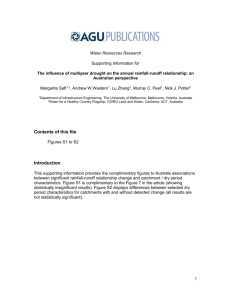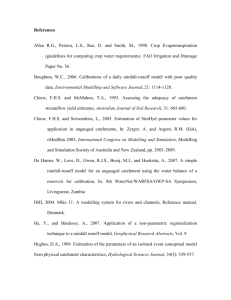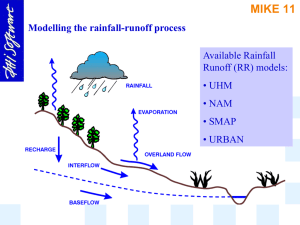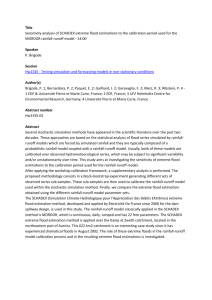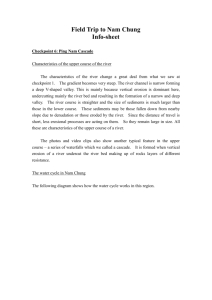Since Nzhelele River at Siloam Village is ungauged and no
advertisement
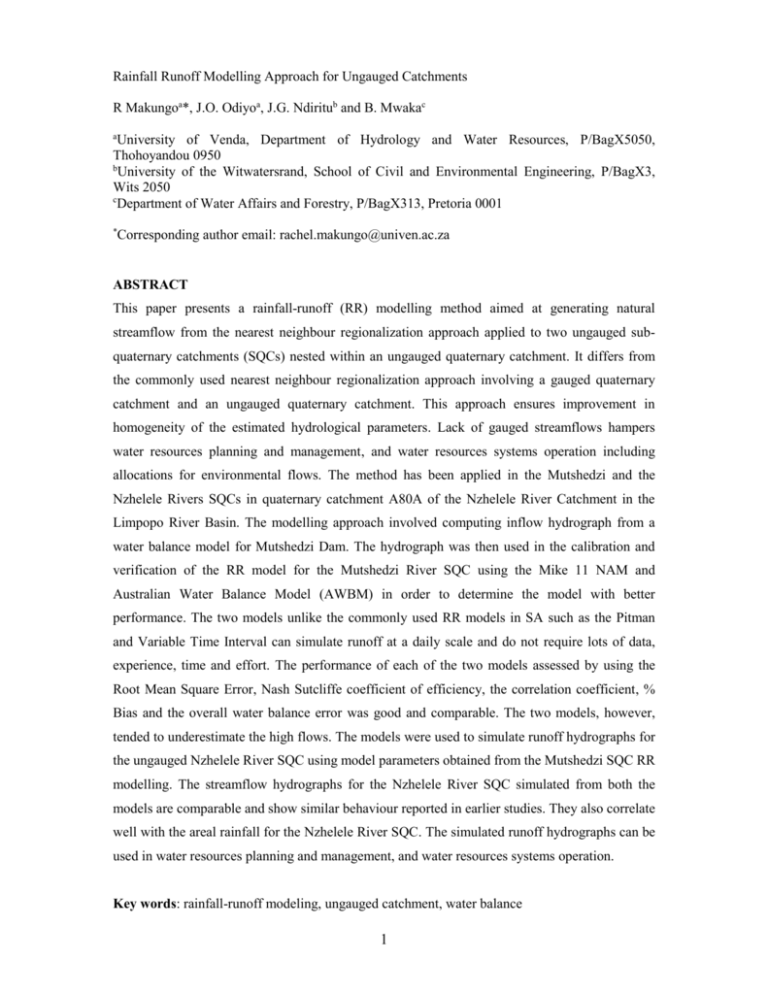
Rainfall Runoff Modelling Approach for Ungauged Catchments R Makungoa*, J.O. Odiyoa, J.G. Ndiritub and B. Mwakac a University of Venda, Department of Hydrology and Water Resources, P/BagX5050, Thohoyandou 0950 b University of the Witwatersrand, School of Civil and Environmental Engineering, P/BagX3, Wits 2050 c Department of Water Affairs and Forestry, P/BagX313, Pretoria 0001 * Corresponding author email: rachel.makungo@univen.ac.za ABSTRACT This paper presents a rainfall-runoff (RR) modelling method aimed at generating natural streamflow from the nearest neighbour regionalization approach applied to two ungauged subquaternary catchments (SQCs) nested within an ungauged quaternary catchment. It differs from the commonly used nearest neighbour regionalization approach involving a gauged quaternary catchment and an ungauged quaternary catchment. This approach ensures improvement in homogeneity of the estimated hydrological parameters. Lack of gauged streamflows hampers water resources planning and management, and water resources systems operation including allocations for environmental flows. The method has been applied in the Mutshedzi and the Nzhelele Rivers SQCs in quaternary catchment A80A of the Nzhelele River Catchment in the Limpopo River Basin. The modelling approach involved computing inflow hydrograph from a water balance model for Mutshedzi Dam. The hydrograph was then used in the calibration and verification of the RR model for the Mutshedzi River SQC using the Mike 11 NAM and Australian Water Balance Model (AWBM) in order to determine the model with better performance. The two models unlike the commonly used RR models in SA such as the Pitman and Variable Time Interval can simulate runoff at a daily scale and do not require lots of data, experience, time and effort. The performance of each of the two models assessed by using the Root Mean Square Error, Nash Sutcliffe coefficient of efficiency, the correlation coefficient, % Bias and the overall water balance error was good and comparable. The two models, however, tended to underestimate the high flows. The models were used to simulate runoff hydrographs for the ungauged Nzhelele River SQC using model parameters obtained from the Mutshedzi SQC RR modelling. The streamflow hydrographs for the Nzhelele River SQC simulated from both the models are comparable and show similar behaviour reported in earlier studies. They also correlate well with the areal rainfall for the Nzhelele River SQC. The simulated runoff hydrographs can be used in water resources planning and management, and water resources systems operation. Key words: rainfall-runoff modeling, ungauged catchment, water balance 1 1. Introduction Streamflow is one of the most important hydrological variables required for water resources planning and management, and water resources systems operation including allocations for environmental flows. However, not all rivers are gauged for streamflow data. Rainfall-runoff models have been used to predict streamflow in ungauged catchments in many studies. Rainfallrunoff modelling requires streamflow data for calibration and validation. Since such data is not available in ungauged catchments, water balance from reservoirs can be used to generate streamflow. An ungauged catchment is one with inadequate records (in terms of both data quantity and quality) of hydrological observations to enable computation of hydrological variables of interest (both water quantity and/or quality) at the appropriate spatial and temporal scales, and to the accuracy acceptable for practical applications (Sivapalan et al., 2003). For example, if the variable of interest has not been measured at the required resolution or for the length of period required for predictions or for model calibration, the catchment would be classified as ungauged with respect to this variable (Sivapalan et al., 2003). Ungauged catchments are common in rural and remote areas, for example Nzhelele River Catchment in the Limpopo Province of South Africa which is the study area of this research. De Hamer et al. (2007) and Liebe et al. (2008) have used water balance from a reservoir to generate streamflow. De Hammer et al. (2007) used the water balance of a reservoir for calibrating a rainfall-runoff model for two small ungauged catchments in Zimbabwe. The inflow was estimated by relating the increase in water level after a rain event and the dimensions of the reservoirs. Liebe et al. (2008) related a remotely sensed time series of reservoir surface areas with the known relationship between reservoir volume and surface area to obtain changes in reservoir storage. These were used to calibrate and verify flows from a water balance model in the Upper East Region of Ghana. The limitations of this approach are data requirements, especially the repeated coverage with satellite images, can be challenging and expensive if these data cannot be 2 obtained through a cost-free arrangement; the application of the method requires trained personnel who are familiar with remote sensing, GIS, and hydrology. The accuracy of storage volume estimates determined with remote sensing is higher where reservoirs have gentle side slopes, but may be less accurate where topography is steep. The current study differs from that of Liebe et al. (2008) because it uses the observed data sets including dam water levels (used to compute the dam storage), rainfall, evaporation, uncontrolled spills and abstractions in the water balance model to estimate the inflow hydrograph into the reservoir. Furthermore, the storage-area relationships for computing dam water storages are specifically for Mushedzi Dam unlike those of Liebe et al. (2008) which were based on regional area-volume relationships, and hence gives more reliable estimates. The computation of the inflows with daily data for a longer period (9 years) as compared to studies by De Hamer et al. (2007) and Liebe et al. (2008) which used daily data for 2 years and 3 months respectively is another merit of the current method. This method is likely to produce an inflow time series which is more natural, realistic and representative since it is based on computations from daily observed data for a relatively long period. This type of study has never been done in the study area. Mike 11 NAM and AWBM models proposed for RR modelling for ungauged sub-quaternary catchments in the study unlike the commonly used RR models in SA such as the Pitman and Virtual Time Interval can simulate runoff at a daily scale and do not require lots of data, experience, time and effort. Regionalization techniques are used to transfer model parameters from catchments with known parameters to ungauged catchments of similar hydrological characteristics. Regionalization techniques that are commonly used include the model averaging framework (McIntyre et al., 2005 and Reichl et al., 2006); the use of parameter sets from the closest upstream and downstream catchments; the parameter regression approach (Hughes, 1989; Servat and Dezetter, 1993; Seibert, 1999; Peel et al., 2000; Merz and Bloschl, 2004 and Vogel, 2005) and the use of parameter values from the nearest gauged catchment (nearest neighbour 3 approach) (Merz and Bloschl, 2004; Chiew and Siriwardena, 2005; and He and Bárdossy, 2007). The nearest neighbour approach has been found to produce the best results as compared to all the above methods in studies such as Merz and Bloschl (2004) and Chiew and Siriwardena (2005). The performance of the models is measured by the Nash Sutcliffe coefficient of efficiency (E), correlation coefficient (R), the root mean square error (RMSE), the overall water balance error and % Bias (PBIAS). The coefficient of efficiency expresses the proportion of variance of the recorded runoff that can be accounted for by the model and provides a direct measure of the ability of the model to reproduce the recorded flows (Boughton, 2006). E = 1.0 indicates that all the estimated flows are the same as the recorded flows (Boughton, 2006). In general, E values greater than 0.6 suggest a reasonable modelling of runoff and E values greater than 0.8 suggest a good modelling of runoff for catchment yield studies (Chiew and McMahon, 1993). R describes the degree of co-linearity between simulated and measured data (Moriasi et al., 2007). If R = 1, a perfect positive linear relationship exists between simulated and measured data (Moriasi et al., 2007). R values greater than 0.5 are considered acceptable (Van Liew et al., 2007). The RMSE values tend to be zero for perfect agreement between observed and simulated values (Shamsudin and Hashim, 2002). The acceptable ranges of the OWBE are ±5-10%. PBIAS measures the tendency of the simulated flows to be larger or smaller than the observed flows (Yapo et al., 1996). The optimal value is 0 % while positive values indicate a tendency to overestimate, and negative values indicate a tendency to underestimate the simulated flows (Yapo et al., 1996). Moriasi et al. (2007) suggested that acceptable PBIAS values should be within ±25%. This study was aimed at developing a RR modelling approach for generating natural streamflow time series data for ungauged sub-quaternary catchments using neighbouring ungauged subquaternary catchment with a gauged reservoir. The two ungauged sub-quaternary catchments are within an ungauged quaternary catchment. 4 2. Modelling approach 2.1 Data requirements and sources The required data sets include rainfall, evaporation, uncontrolled spills, downstream flow releases, dam water levels, storage-area relationship for Mutshedzi Dam, domestic abstractions, area under irrigation, crop factors, types of crops grown and the irrigation schedule. Evaporation, uncontrolled spills, downstream flow releases, dam water levels and storage-area relationships for Mutshedzi Dam were obtained from the Department of Water and Environmental Affairs (DWEA) while rainfall data was obtained from the South African Weather Services (SAWS). Irrigation data and the crop factors were obtained from the farmers and Allen et al. (1998) respectively. The domestic abstractions were obtained from the Mutshedzi Water Treatment Plant. The station numbers for the rainfall, evaporation, downstream flow releases and uncontrolled spills are 0766327, A8E004, A8H011 and A8R004 respectively. These data sets were used in the computation of the inflows into the Mutshedzi Dam. The locations of rainfall, evaporation and streamflow stations are shown in Fig.1. The crop factors, the area under irrigation, crops grown, irrigation schedule and the evaporation data from station number A8E004 were used to compute the irrigation water demand. This was done to determine the highest amount of water required for irrigation, and was also useful in establishing the significance of irrigation water use and its influence on the computed inflows to justify the exclusion of daily irrigation time series demand from the water balance. This was necessary because it was not possible to obtain the daily irrigation time series data. Rainfall data for station numbers 0766327, 0766324, 0766269 and 0766563 and evaporation data for station number A8E004 were used as inputs into the Mike 11 NAM rainfall-runoff model. The 5 evaporation data from A8E004 station together with the weighted areal rainfall computed in Mike 11 NAM rainfall-runoff model were also used for rainfall-runoff modelling using the AWBM. 2.2 Data analysis methods Determining inflow time series into Mutshedzi Dam The inflow into the dam has been computed using the water balance equation below. I dam Qd Qirr Qs E s R Qr (1) where, Idam is the inflow into the dam, Qd are the domestic abstractions, Qirr are the irrigation abstractions, Qs are the uncontrolled spills, E is the evaporation, R is the rainfall, Qr are the downstream flow releases and s is the change in storage. Equation 1 was used to compute the inflow into the dam taking into account the estimated irrigation water demand. To compute the inflow into the dam excluding the estimated irrigation water demand, the following equation was used: I dam Qd Qs E s R Qr (2) This was done to establish the significance of irrigation water use on the computed inflows and to justify the exclusion of daily irrigation time series demand from the water balance. Initial checking of all the data sets and minimum patching of evaporation data series were done. Minimum patching of daily domestic abstractions was also done where possible (i.e. in cases where there were missing data for a long period of time, e.g. 1 year, patching was not done and that period was therefore not included in the analysis). The irrigation water demands for the two irrigation schemes (Cordon and Phadzima) located upstream of Mutshedzi Dam was computed using equation 3: Qirr ETo A (3) where Qirr = daily irrigation demand in m3/day, A = area irrigated daily in m2/day and ETo = the reference crop evapotranspiration in mm/day. Further details on computation of ETo are found in Makungo (submitted). 6 The dam downstream flow releases were only available for the period 1991/02/13-2000/02/15 while the domestic abstractions were available from 1994/04/22-2007/10/31 with some years having completely no data. This has limited the computation of the water balance to the period 1994/04/22-1999/03/06. Though the computation would have been expected to continue up to 2000/02/15, this was not possible because there were no domestic abstractions data between this date and 1999/03/06. Rainfall-runoff modelling for Mutshedzi and Nzhelele River sub-quaternary catchments Delineation of the sub-quaternary catchments The sub-quaternary catchments drained by the upper part of Nzhelele and Mutshedzi Rivers in quaternary catchment A80A were delineated from the 1:50000 topographical map and a topographical map obtained from the GRDM software and their respective areas determined. Mike 11 NAM and AWBM models setup, calibration and verification The sub-quaternary catchment area, weighted areal rainfall, evaporation and streamflow data were required for the models set up for the Mutshedzi sub-quaternary catchment. These data were input into the models and were used in the calibration and verification. The weighted areal rainfall was automatically computed by the Mike 11 NAM rainfall-runoff model from point rainfall from station numbers 0766269 and 0766327 using Thiessen polygon method. The Shuffled Complex Evolution optimizer in-built within Mike 11 was used in auto calibration using the RMSE as an objective function. Rosenbrock single start optimization technique was selected for the most efficient AWBM model calibration also using RMSE as an objective function. The daily data sets for a period of three years (1994/04/22-1997/04/22) and a period of two years (1997/04/23-1999/03/06) were used for model calibration and verification respectively. Three years is the minimum calibration period recommended by DHI (2004). 7 Verification was performed to assess whether the calibrated parameter values could be used to successfully estimate streamflow for an independent test period that was not used to calibrate the model. The E, RMSE, OWBE, R and PBIAS were used to define efficient calibration and verification of the models. Equations 4-8 were used to compute the OWBE, E, RMSE, R and PBIAS respectively. Q Qobs,i Q Qobs,i n E 1 2 sim,i i 1 n obs,i i 1 (4) 2 where Qobs = observed flow (m3/s); Qsim = simulated flow (m3/s) and Qobs is the mean of the observed flow (m3/s), n = total number of time steps. 1 2 1 n 2 RMSE Qobs,i Qsim,i n i 1 OWBE R (5) 1 n Qobs,i Qsim,i n i 1 Q n i 1 Q obs, i n i 1 obs, i (6) Qobs, i Qsim, i Qsim, i Qobs, i 2 Q n i 1 Qsim, i 2 sim, i n Qobs, i Qsim,i PBIAS i 1 n 100 Qobs, i i 1 (7) (8) Weighted areal rainfall computed from observed point daily rainfall for station numbers 0766327, 0766324, and 0766563; observed daily evaporation and model parameters obtained from Mutshedzi sub-quaternary catchment calibration were used for Mike 11 NAM and AWBM rainfall-runoff modelling for the Nzhelele River sub-quaternary catchment. The data for the period 1991/07/01-2000/07/31 was used in the latter simulations. 8 3. Results and discussions 3.1 Computed inflow into Mutshedzi Dam The inflow into Mutshedzi Dam computed from the water balance equation (Eq. 2) using the downstream flow releases, domestic water abstractions, rainfall, evaporation, uncontrolled spills and dam water storage has been presented in Fig. 2. The computed inflow time series was considered reasonable although 6.8% of the inflows were negative. The negative flows summed up to only 7.3% of the sum of the positive flows. 90% of the negative flows were less than 10% of the mean flow. Following the precedence set by Ndiritu et al. (2008), the negative flows were considered negligible and likely to be within the bounds of normal measurement errors. All the negative flows were therefore converted to zero flows. In Ndiritu et al. (2008), 17% of the inflows were negative and summed up to only 0.9% of the sum of positive flows. The latter study found that 92 % of the negative flows were less than 10% of the mean flow and were considered negligible and likely to be within the bounds of normal measurement errors. This value is comparable with that obtained in this study, though the % sum of the negative inflows to the total flows is lower than that of 17% obtained by Ndiritu et al. (2008). The discontinuity observed in the inflow time series between 1996/02/01 and 1996/03/31 was because the domestic abstractions data for Mutshedzi Water Treatment Plant were not available for that period. It was therefore not possible to compute inflow time series using water balance equation during that period. The inflows into the dam computed above from the water balance equation in which the irrigation water demand was excluded was compared with the inflows into the dam computed with the irrigation water demand included (Fig. 3). The results show that incorporating the irrigation water demand in the computation has negligible effect compared to the scenario that excludes the irrigation water demand in its computation. Its exclusion increases the inflows by a maximum of 0.004 m3/day in some of the days. This shows that the actual irrigation water demand has negligible effects on the inflows into the dam. This justifies the exclusion of this component in 9 the computation of the inflow time series for Mutshedzi Dam from the water balance equation. This was necessitated by lack of daily time series of irrigation water demand. 3.2 Rainfall-runoff modelling for Mutshedzi and Nzhelele sub-quaternary catchments The delineated sub-quaternary catchments of the Nzhelele and Mutshedzi Rivers whose areas have been used in rainfall-runoff modelling are represented by A and B respectively (Fig. 4). Their estimated areas are 98.25 and 85 km2 respectively. Several trials during the calibration of Mike 11 NAM for Mutshedzi SQC revealed that the most sensitive parameters are L max, Umax, CQOF and CKIF, whose definitions are provided in Table 1. These findings are similar to those in Keskin et al. (2007). The parameters Lmax, Umax, CQOF and CKIF define the base flow in the basin (Keskin et al., 2007). It was also found that the parameters TOF and TIF (Table 1) do not have much influence on the total runoff volume. This finding was also confirmed by Keskin et al. (2007) while calibrating a rainfall-runoff model for Yuvacik Dam Basin in Turkey. All the parameters obtained from the Mike 11 NAM calibration for Mutshedzi SQC are given in Table 1. Similarly, the parameters obtained from the AWBM model calibration for Mutshedzi SQC are given in Table 2. The parameters from both the models fall within the acceptable lower and upper limits of the individual model parameters. The Mike 11 NAM and AWBM rainfall-runoff simulated and observed results have been presented in Figs. 5 and 6, and compared using the measures of performance in Table 3. The E for the calibration run is slightly lower than the E for the verification run for both models. This may have been because of the missing data between the periods 1996/02/01 and 1996/03/01 which may have affected the model calibration and resulted in a lower E value. However, the high E value for the verification period indicates that reasonably good model parameters were obtained during the calibration. 10 Shamsudin and Hashim (2002) indicated that missing data, on site data acquisition and the nature of rainfall pattern affected calibration of the Mike 11 NAM rainfall runoff modelling for the Layang River, resulting in an E value of 0.75. The study area is characterized by uneven rainfall distribution and missing data that could have affected the E value. The E values obtained in the current study fall within the range 0.66-0.82 obtained by Vaitiekūnienė (2005) during the calibration of the Mike 11 NAM rainfall-runoff model for 66 catchments in the Lithuanian River Basin. In the latter study, the lower E values were due to inadequately distributed precipitation data and errors in the observed discharge. The E values varying from 0.16 to 0.85, with a median across 37 gauged catchments of 0.60 were obtained in the latter study. Thus, E values obtained in this study are acceptable as they are within the ranges obtained in other studies and fall within the reasonable and good modelling range described by Chiew and McMahon (1993). The E values for the calibration and verification runs for both the models are greater than 0.6 and they suggest a reasonable modelling of runoff according to Chiew and McMahon (1993). The E values for the AWBM rainfall-runoff model are comparable though slightly higher than those of MIKE 11 NAM rainfall-runoff model (Table 3). The computed R for both the calibration and verification runs with both models (Table 3) are acceptable according to Van Liew et al. (2007). Since the R values are all greater than 0.8 and are approaching 1, the relationship between the simulated and measured values tends towards a perfect positive linear relationship according to Moriasi et al. (2007). The computed RMSE for both the calibration and the verification runs for both models (Table 3) are reasonable as they fall within the ranges obtained in other studies. RMSE values in the ranges 0.067-0.92 and 0.05-1.03 have been obtained in studies by Madsen et al. (2002) and Madsen (2003) respectively. The RMSE values obtained from both the calibration and verification of the Mike 11 NAM rainfallrunoff model are lower than those obtained from the AWBM rainfall-runoff model. Thus Mike 11 NAM model did slightly better than AWBM with regard to RMSE since a perfect value according to Shamsudin and Hashim (2002) is zero. 11 The OWBE for both the models (Table 3) fall within the acceptable ranges of ±5-10% (Madsen et al., 2002). The OWBE obtained from the AWBM and Mike 11 NAM rainfall-runoff models suggest that the models underestimated the simulated runoff since the results indicate that Qobs is greater than Qsim from Eq. 6. However, the OWBE obtained from the AWBM are lower than those obtained from Mike 11 NAM due to the fact that AWBM overestimated some of the peak flows while Mike 11 NAM underestimated some of the peak flows. Madsen et al. (2002) indicated that the inherent uncertainties in measuring the catchment average rainfall and the corresponding runoff make it difficult to obtain perfect water balance. The computed PBIAS for the Mike 11 NAM were -10.45% and -10.09% respectively while PBIAS for AWBM calibration and verification runs were -3.94% and -5.36% respectively (Table 3). The PBIAS values obtained in the calibration and validation of Mike 11 NAM and AWBM are acceptable and indicate underestimation of simulated runoff according to Yapo et al. (1996). The Mike 11 NAM model calibration and verification runs underestimated most of the peak flows (Figs. 5 and 6). The peak flow which occurred on 1998/10/18 was well predicted though it was of relatively small magnitude (Fig.6). Most of the low flows for the calibration run were well predicted (Fig. 5). The verification run underestimated the flows on the falling limb of a peak flow hydrograph between 1997/04/23 and 1997/07/09 (Fig. 6). The estimation of the rest of the low flows on verification run approached the observed values if not slightly underestimated them. The model underestimated most of the peak flows for the calibration run (Fig. 5). The AWBM overestimated most of the small to medium peak flows and underestimated the major peak flows in both calibration and verification runs (Figs. 5 and 6). For example, the peak flows which occurred on 1995/03/28, 1995/08/12, 1996/12/22, 1997/09/15, 1997/12/09, 1998/10/20 and 1998/11/10, etc. were overestimated while the peak flows which occurred on 1995/02/20, 1996/01/24, 1996/07/17, 1998/12/15 and 1999/01/12 were underestimated The model generally predicted the low flows correctly in the calibration and verification runs except for the flows on 12 the falling limb of a peak hydrograph between April and early September 1997 which were underestimated (Fig. 6). Thus, both models were able to estimate the low flow events perfectly for both the calibration and the verification runs, except in a few cases where they underestimated the low flows (Figs. 5 and 6). Good and reasonable objective measures (i.e. RMSE, E, R, PBIAS and OWBE) were obtained during calibration and verification of both the Mike 11 NAM and AWBM rainfall-runoff models (Table 3). This indicates that reasonably good model parameters were obtained during model calibration. Thus, the parameter sets obtained in calibration can be transferred to another subquaternary catchment with similar hydrological conditions for use in rainfall-runoff modelling. The results in Table 3 and Figs. 5 and 6 shows that the AWBM and Mike 11 NAM rainfall-runoff models have generally comparable performance in the Mutshedzi SQC though the AWBM performed relatively better than the Mike 11 NAM. It was therefore decided to simulate the runoff hydrograph for the ungauged Nzhelele River SQC, which is within the same quaternary catchment, using both the models. The results were then compared. The simulated runoff for Nzhelele River has been obtained using the model parameters in Tables 1 and 2 which were adopted based on the modified nearest neighbour regionalization technique. The simulated flows are comparable though the AWBM simulated flows are generally higher than the Mike 11 NAM simulated flows (Fig.7). Figures 8 and 9 below show the correlation of the simulated runoff and the areal rainfall hydrographs for the Nzhelele River SQC. The graphs show that the major peak rainfall events are well correlated with the major peak runoff events. This verifies the runoff simulated by the AWBM and Mike 11 NAM models for Nzhelele River at Siloam Village. 13 Nethengwe (2007) and Odiyo et al. (2007) have indicated that the Nzhelele River Catchment is dominated by dry rainfall years (drought) which result in low flows. This is because Nzhelele River is located on the leeward side of the Soutpansberg Mountains and receives low rainfall resulting in low runoff. However, there are sporadic flood events with return periods greater than 1:15 years which occur in the Nzhelele River (Nethengwe, 2007). These contribute to the occasional flood peaks. These confirm the dominance of low flows and occasionals sporadic floods. The 1995/96 hydrological year flood event predicted in this study (Fig. 7) was also predicted by Nethengwe (2007) on performing flood analysis for the Nzhelele River downstream of the Nzhelele Dam, though of different magnitude. Nethengwe (2007) could not perform the flood analysis for the hydrological year 1999/2000 because of lack of streamflow data for that year. However, a number of studies such as Smithers et al. (2001) and Odiyo and Maluleke (2005) have indicated that a major flood event occurred in February 2000 in the Limpopo Province and the north eastern parts of South Africa. The coincidence of the major flood peaks with those obtained in other studies shows that the AWBM and Mike 11 NAM models were able to simulate the runoff hydrograph for Nzhelele River at Siloam Village well. 4. Conclusions A water balance model has been used to compute the inflow hydrograph into the Mutshedzi Dam. The inflow time series computed while incorporating the irrigation water demand and not incorporating the irrigation water demand were compared to establish the significance of irrigation water use on the computed inflows. This was necessary to justify the exclusion of daily irrigation time series demand from the water balance, because of lack of data. Despite applying a method that overestimated the irrigation water demand, the inclusion of the computed irrigation water demand in the water balance equation was found to have negligible effects on the computed inflows. The inflow time series computed without the incorporation of the irrigation water 14 demand was therefore adopted for the calibration and verification of the rainfall-runoff models for Mutshedzi River SQC using the Mike 11 NAM and AWBM. Efficient calibration and verification was achieved by using both the models. The two model results were compared in order to deduce the model which simulates hydrological processes of the Mutshedzi River SQC better. The performance of Mike 11 NAM and the AWBM rainfallrunoff models were assessed using measures of goodness of fit between the simulated and observed runoff including RMSE, E, R, OWBE and PBIAS. The Mike 11 NAM and AWBM rainfall-runoff models performances were good and comparable though the AWBM performance was relatively better than that of the Mike 11 NAM. It was therefore decided to use both models in the simulation of the streamflow hydrograph for Nzhelele River SQC and compare the results. The streamflow hydrograph for the Nzhelele River SQC simulated from both the models is comparable and show similar behaviour reported in earlier studies. It also correlates well with the areal rainfall for the Nzhelele River SQC from upstream to Siloam Village. Acknowledgements The authors wish to acknowledge the Department of Water and Environmental Affairs, particularly Mrs. Celiwe Ntuli, for supporting this study in order to promote capacity building. The Danish Hydraulic Institute through South African representative Mr Jason Hallowes of Clear Pure Waters is also highly acknowledged for providing the educational training version of Mike 11 modelling package. 15
